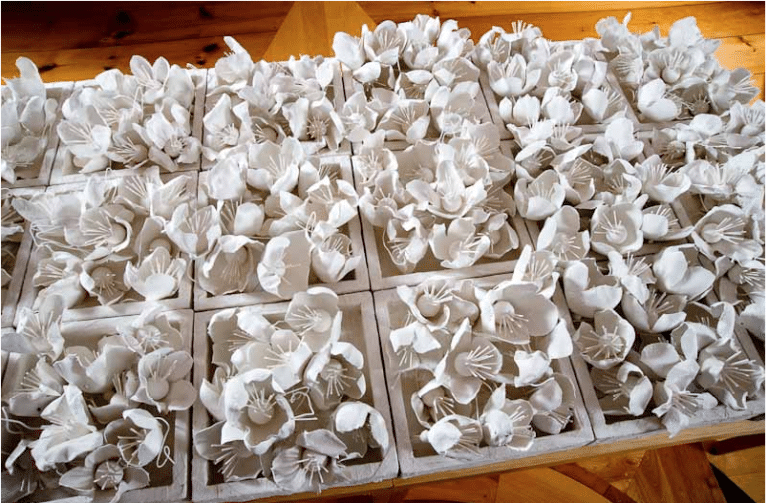
B. Amore
“In Flanders field the poppies blow Between the crosses row on row . . .”
The lines of the poem, hypnotic in their rhythm and rhyme, reverberate as the leitmotif in the work of multi-media artist, Fran Bull. Poems often inspire Bull’s work but rarely in such a profound manner as in this exhibit, In Flanders Fields, which is essentially a meditation not only on death, but on life itself, its fragility, its resilience. Floating through the space are gossamer scrolls, Prayers, delicately printed with evanescent, mysterious images of intertwined bones drawn from five thousand year old skeletons of Neolithic lovers unearthed in Mantua, Italy in 2007. They speak to the persistence of memory and the power of love. The hangings provide a counterpoint to the density of the nine-foot square black and white etching, The Fallen Ones, that provides the focal point around which the exhibit revolves. Bull has carved into the etching plate, tracing the imagined faces of fallen soldiers, each lost in his own enigmatic death; each an interplay of light and dark, figure and ground, pain and peace. The incisive consciousness of the artist uses the most traditional and the most experimental etching techniques to give voice to ruminations on the complex nature of human beings who are capable of both the most exquisite acts of love and the harshest forms of life-negating acts.
Slate black and iron gray birds are suspended overhead, their wings spread like fingers casting delicate shadows onto the living beings who move below them. The motif of the nine squares is echoed in the sculptural reliefs of white heads punctuating the planes of the walls; each chalk white face enclosed in its square pine box, into which viewers have been invited to tuck their own thoughts written on soft red rice paper. Interspersed with the wall reliefs are large scale etchings, in both bright and subdued tones, which play on the more hopeful themes of the larks and poppies from the original poem. The layered transparencies of the forms appear as fluttering leaves shimmering among the silent rigid frames of the pine boxes.
Bull’s sense of theater is in full sway in the installation Lysistrata and her Band of Women, drawn from Aristophanes’ play about the Peloponnesian War in which the women of Greece collectively denied their sexual favors until their husbands had negotiated peace. Like caryatids, they form a solemn procession throughout the exhibit inviting us to join the chorus of protest, albeit in our own way. In Flanders Fields is an epic and elegiac hymn composed of subtle yet powerful notes reminding us of the constant interplay between life and death, not only on the world stage, but in our own day to day lives.
* A portion of this essay was printed as a review, In Flanders Fields, Art New England, Dec-Jan, 2009.